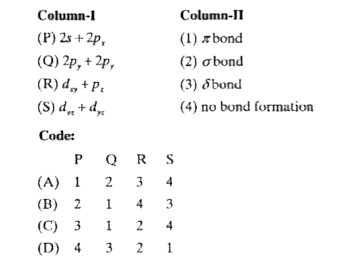The overlapping of orbitals in benzene is of the type
sp2−sp2
sp3−sp3
sp−sp
p−p
The correct Answer is:D
To determine the type of orbital overlapping in benzene, we can follow these steps:
Step 1: Understand the Structure of Benzene
Benzene (C₆H₆) is a cyclic compound consisting of six carbon atoms arranged in a hexagonal ring. Each carbon atom is bonded to one hydrogen atom.
Hint: Recall the molecular formula of benzene and its hexagonal structure.
Step 2: Identify the Hybridization of Carbon Atoms
In benzene, each carbon atom undergoes sp² hybridization. This means that one s orbital and two p orbitals combine to form three sp² hybrid orbitals, while one p orbital remains unhybridized.
Hint: Remember that sp² hybridization involves one s orbital and two p orbitals.
Step 3: Determine the Bonding in Benzene
Each carbon atom forms sigma (σ) bonds with its two neighboring carbon atoms and one hydrogen atom using the sp² hybrid orbitals. The unhybridized p orbital on each carbon atom is perpendicular to the plane of the ring.
Hint: Sigma bonds are formed by head-on overlapping of orbitals, while p orbitals are involved in pi bonding.
Step 4: Analyze the Overlapping of p Orbitals
The unhybridized p orbitals from adjacent carbon atoms overlap sideways to form pi (π) bonds. This results in a delocalized electron cloud above and below the plane of the benzene ring.
Hint: Pi bonds are formed by the lateral overlap of p orbitals.
Step 5: Conclusion on the Type of Overlapping
The overlapping of orbitals in benzene is primarily of the type p-p overlapping, which leads to the formation of the delocalized π system.
Hint: Look for the type of orbital involved in the bonding when considering the overlapping.
Final Answer
The overlapping of orbitals in benzene is of the type p-p overlapping.
Benzene (C₆H₆) is a cyclic compound consisting of six carbon atoms arranged in a hexagonal ring. Each carbon atom is bonded to one hydrogen atom.
In benzene, each carbon atom undergoes sp² hybridization. This means that one s orbital and two p orbitals combine to form three sp² hybrid orbitals, while one p orbital remains unhybridized.
Each carbon atom forms sigma (σ) bonds with its two neighboring carbon atoms and one hydrogen atom using the sp² hybrid orbitals. The unhybridized p orbital on each carbon atom is perpendicular to the plane of the ring.
The unhybridized p orbitals from adjacent carbon atoms overlap sideways to form pi (π) bonds. This results in a delocalized electron cloud above and below the plane of the benzene ring.
The overlapping of orbitals in benzene is primarily of the type p-p overlapping, which leads to the formation of the delocalized π system.
The overlapping of orbitals in benzene is of the type p-p overlapping.
Topper's Solved these Questions
- BOOK - ERRORLESSCHAPTER - HYDROCARBONSEXERCISE - PAST YEAR QUESTIONS88videos
HYDROCARBONS
- BOOK - ERRORLESSCHAPTER - HYDROCARBONSEXERCISE - ASSERTION & REASON18videos
HYDROCARBONS
- BOOK - ERRORLESSCHAPTER - HYDROCARBONSEXERCISE - NCERT BASED QUESTION (ALKYNE)67videos
HYDROCARBONS
- BOOK - ERRORLESSCHAPTER - GENERAL ORGANIC CHEMISTRY EXERCISE - ASSERTION AND REASON14videos
GENERAL ORGANIC CHEMISTRY
- BOOK - ERRORLESSCHAPTER - HYDROGENEXERCISE - ASSERTION & REASON6videos
HYDROGEN
Similar Questions
Knowledge Check
- Question 1 - Select One
The strength of bonds formed by overlapping of atomic orbitals is in the order .
As−s>s−p>p−pBs−s>p−p>s−pCs−p>s−s>p−pDp−p>s−s>s−p - Question 2 - Select One
A covalent bond will be formed by the overlapping of atomic orbitals having single electron of opposite spin, according to the overlapping of atomic orbitals the covalent bond may be of two types :
(i) Sigma bond (σ) (ii) Pi bond (π)
Sigma bond is stronger bond than the Pi-bond. If atomic orbitals overlap about the nuclear axis then sigma bond is formed but when atomic orbitals overlap sideway then Pi-bond is formed.
Compound having maximum bond angle is :ABBr3BBCl3CBF3Dnone of these - Question 3 - Select One
The strength of bonds formed by overlapping of atomic orbitals is in the order:
As−s>s−p>p−pBs−s<p−p<s−pCs−p<s−s<p−pDp−p<s−s<s−p
Which statement is correct for ionic bond?
(a) It is non-directional .
(b) It is formed by overlapping of orbitals
(b) It is formed by overlapping of orbitals.
(c ) it is formed by the elements with same EN
(d) Both (a) and (b) are correct .View SolutionOverlap Of Atomic Orbitals
View SolutionA covalent bond will be formed by the overlapping of atomic orbitals having single electron of opposite spin, according to the overlapping of atomic orbitals the covalent bond may be of two types :
(i) Sigma bond (σ) (ii) Pi bond (π)
Sigma bond is stronger bond than the Pi-bond. If atomic orbitals overlap about the nuclear axis then sigma bond is formed but when atomic orbitals overlap sideway then Pi-bond is formed.
The strength of bonds formed by 2s-2s,2p-2p and 2p-2s overlap has the order :View SolutionA covalent bond will be formed by the overlapping of atomic orbitals having single electron of opposite spin, according to the overlapping of atomic orbitals the covalent bond may be of two types :
(i) Sigma bond (σ) (ii) Pi bond (π)
Sigma bond is stronger bond than the Pi-bond. If atomic orbitals overlap about the nuclear axis then sigma bond is formed but when atomic orbitals overlap sideway then Pi-bond is formed.
The strength of bonds formed by 2s-2s,2p-2p and 2p-2s overlap has the order :View SolutionThe angle between the overlapping of one s-orbital and one p-orbital is
View Solution


